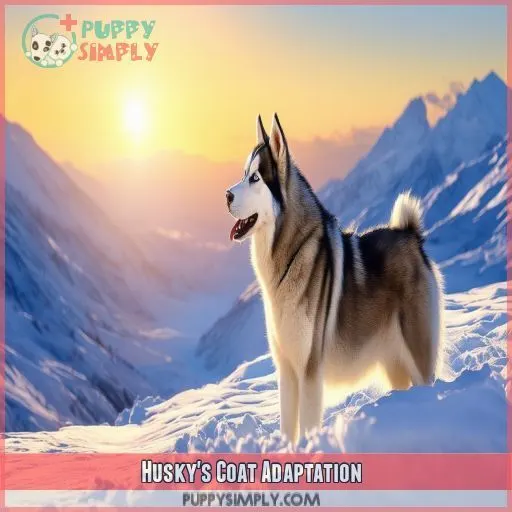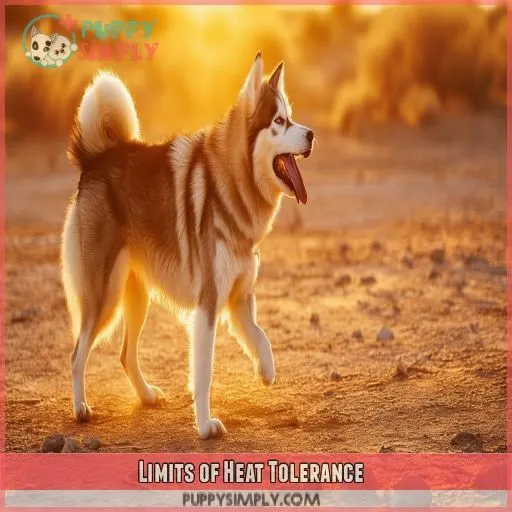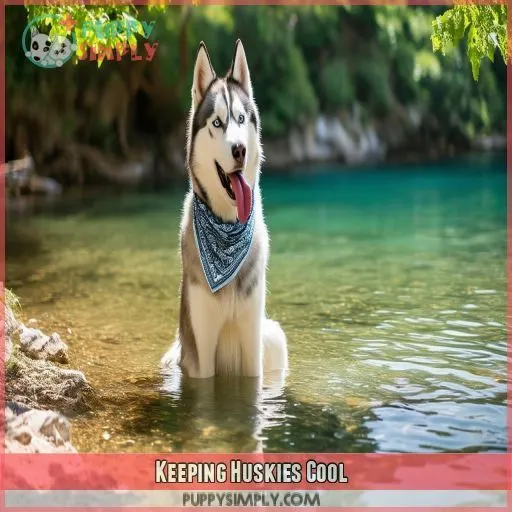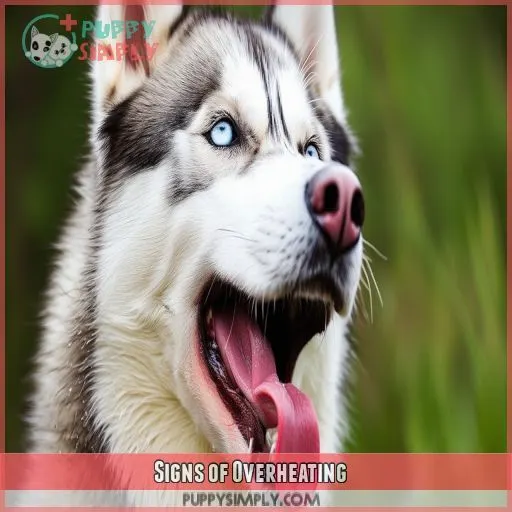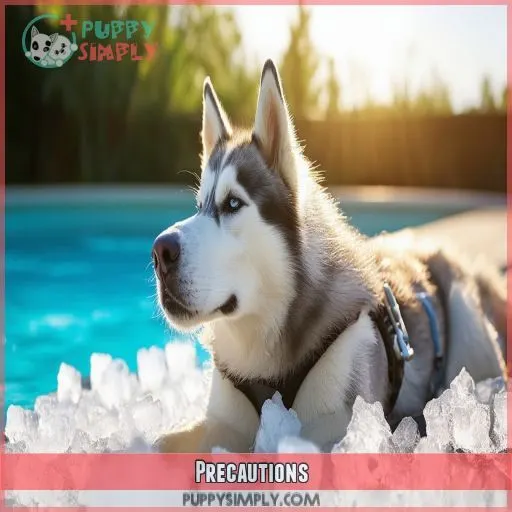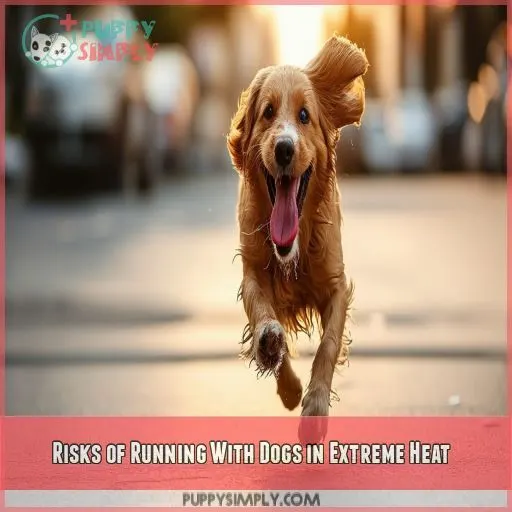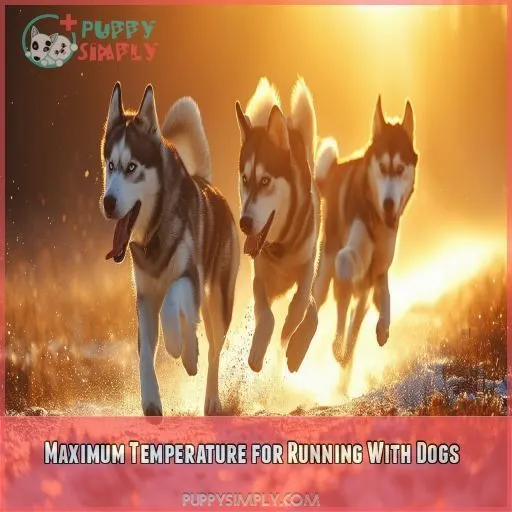This site is supported by our readers. We may earn a commission, at no cost to you, if you purchase through links.

When it’s over 90°F (32°C), keep outdoor activities to a minimum. Provide plenty of water, shade, and air conditioning. Never shave their coat, as it protects them from heat and UV rays.
Watch for signs of overheating like excessive panting or lethargy. Walk your husky during cooler hours and play indoor games on scorching days.
With proper precautions, your husky can adapt to warmer climates. However, there’s more to know about keeping your furry friend safe and comfortable in the heat.
Table Of Contents
- Key Takeaways
- Can Husky Live in Hot Weather?
- Husky’s Coat Adaptation
- Limits of Heat Tolerance
- Keeping Huskies Cool
- Signs of Overheating
- Precautions
- Risks of Running With Dogs in Extreme Heat
- Maximum Temperature for Running With Dogs
- Alternative Activities for Dogs on Hot Days
- Frequently Asked Questions (FAQs)
- What temperature is too hot for huskies?
- Can huskies stay in heat?
- Are huskies prone to heat stroke?
- Can a Husky live in Arizona?
- Can Huskies be groomed differently to cope with heat?
- How does a Huskys diet affect their heat tolerance?
- Are certain Husky colors better suited for hot climates?
- Do Huskies experience seasonal coat changes in warm regions?
- Can Huskies develop heat acclimatization over time?
- Conclusion
Key Takeaways
- Huskies can handle the heat, but they’re not exactly beach bums. Their double coat is like nature’s AC, helping regulate body temp, but when it’s a scorcher out there (over 90°F/32°C), it’s time to chill indoors.
- Keep your furry friend cool as a cucumber with plenty of H2O, shady spots, and some indoor R&R. Think of it as a spa day for your pup – minus the cucumber eye patches!
- Don’t even think about giving your husky a summer buzz cut! That coat is their superhero suit against heat and UV rays. Shaving it off is like sending them into battle without armor.
- When the mercury rises, be your husky’s personal weather station. Watch for signs of overheating like excessive panting or lethargy. If they start acting like they’ve had one too many doggy margaritas, it’s time to cool things down pronto!
Can Husky Live in Hot Weather?
Yes, huskies can live in hot weather, but they require special care. Their unique double coat helps insulate them from heat, but owners must take precautions like providing shade, water, and limiting outdoor activities when temperatures exceed 90°F (32°C) to guarantee their husky’s comfort and safety.
Husky’s Coat Adaptation
You might be surprised to learn that a Husky’s coat is well-adapted for both cold and hot climates. Their thick topcoat repels water and UV rays while their undercoat insulates from heat, and the topcoat’s ability to move air like a fan helps keep them cool in warm weather.
Thick Topcoat Repels Water, Sunshine, and UV Rays
Your husky’s thick topcoat is a marvel of adaptability. It provides:
- Protection from harmful UV rays
- Insulation against intense sunshine
- Water repellency for unexpected showers
This remarkable coat helps regulate your furry friend’s temperature, keeping them cool in hot weather.
Undercoat Insulates From Heat
You’ll be amazed by your husky’s undercoat. It’s not just for winter warmth; it’s a natural insulator against heat too. This double coat helps regulate temperature, keeping your furry friend cool even when the mercury rises. Talk about climate adaptation!
Topcoat Moves Air Like a Fan
You’ll be amazed by your husky’s topcoat adaptation. It’s not just thick; it’s designed to move air like a fan. This natural cooling system helps regulate temperature, working with their unique blood flow and sweat glands to keep them comfortable.
Coat Insulates in Winter and Cools in Summer
You’ll be amazed at your husky’s built-in climate control system. Their coat acts as nature’s air conditioning, insulating against both cold and heat. Even in high humidity, your furry friend stays comfortable thanks to:
- Fur insulation
- Coat thickness
- Natural cooling properties
Can Adapt to Hot Climates
You’ll be pleased to know that your husky can adapt to hot climates. Their remarkable coat insulation works year-round, shedding seasonally to maintain comfort. However, it’s imperative to understand their limits and take precautions to prevent heat exhaustion and overheating.
Limits of Heat Tolerance
You’ll need to be cautious when the temperature rises above 90°F (32°C), as this is too hot for your husky’s outdoor activities. When it reaches 95°F (35°C) or higher, your furry friend will struggle and become fatigued quickly, so it’s best to keep them indoors.
Over 90°F (32°C) Too Hot for Outdoor Activities
When temperatures soar above 90°F (32°C), it’s time to reassess your husky’s outdoor activities. High humidity can make it feel even hotter, so keep a close eye on your furry friend. Remember, breed differences and age factors play a role in heat tolerance. Here are three key points to note:
- Limit exercise intensity to prevent heat stroke
- Use doggie boots or paw wax to protect sensitive paws
- Watch for signs of distress, especially in older dogs or those with health concerns
Running in extreme heat can be dangerous for dogs. Instead, opt for indoor games or early morning walks when it’s cooler. Your husky’s safety should always come first!
Over 95°F (35°C) Causes Struggles and Fatigue
As temperatures climb even higher, your Husky’s heat regulation struggles intensify. At 95°F (35°C) and above, you’ll notice your furry friend’s physiological adaptations working overtime. Their thick coat, usually a blessing, can become a burden.
Keep a close eye on your Husky’s temperature and watch for signs of fatigue. Remember, breed considerations are essential – Huskies aren’t built for scorching summers.
To prevent dehydration, offer plenty of water and cool spots. Consider cranking up the AC or creating a "Husky summer oasis" indoors.
Your pup’s safety is paramount, so don’t push their limits in extreme heat.
Keeping Huskies Cool
To keep your Husky cool in hot weather, provide access to water sources like sprinklers or pools and guarantee they’ve plenty of shade. You can also walk them during cooler hours, confine exercise indoors when it’s extremely hot, and engage them in indoor games like fetch or tug-of-war.
Provide Access to Water (sprinkler, Pool, Lake)
You’ve learned about Huskies’ heat limits, now let’s explore keeping them cool. Water is indispensable. Here are some ways to provide it:
- Set up a sprinkler for playful splashing
- Install a doggy pool for refreshing dips
- Visit lakes for swimming adventures
- Offer fresh, cool water continuously
Ensure Shade (tree, Doghouse)
After providing water, make sure your husky has ample shade. Trees and doghouses offer excellent shelter from the sun’s heat. Here’s a quick guide to creating cooling spots:
| Shade Type | Benefits | Considerations |
|---|---|---|
| Trees | Natural, cool | Seasonal changes |
| Doghouse | Portable, cozy | Needs ventilation |
| Canopy | Versatile, easy | Wind-resistant setup |
| Porch | Accessible, spacious | Limited mobility |
Walk During Cool Hours (morning, Evening)
You’ll want to walk your husky during cool hours to keep them comfortable. Here’s a quick guide:
- Start early morning walks before sunrise
- Schedule evening strolls after sunset
- Adjust timing based on seasonal temperatures
- Monitor your husky’s energy levels during walks
Confine Exercise Indoors During Extreme Heat
During extreme heat, shift your husky’s exercise indoors. You’ve been walking in cooler hours, but when it’s scorching, confine activities inside. Here’s a quick guide:
| Activity | Benefit | Time |
|---|---|---|
| Treadmill | Controlled pace | 15-20 min |
| Stairs | Cardio boost | 10-15 min |
| Hide-and-seek | Mental stimulation | 20-30 min |
Play Indoor Games (fetch, Tug-o-war)
When it’s too hot outside, keep your Husky entertained indoors. Play fetch or tug-o-war to burn energy and strengthen your bond. Indoor games offer:
- Mental stimulation to prevent boredom
- Physical exercise without overheating
- Training opportunities for obedience
- Fun bonding time for you both
Signs of Overheating
You’ll need to watch for signs of overheating in your husky, especially during hot weather. Key indicators include a dry nose and mouth, excessive panting, lack of appetite, disorientation, and lethargy.
Dry Nose and Mouth
Keep an eye on your husky’s nose and mouth in hot weather. A dry, warm nose and sticky gums are red flags for dehydration and overheating. These signs, often accompanied by lack of appetite and disorientation, shouldn’t be ignored in heavy-coated breeds.
Excessive Panting
You’ll notice your husky panting excessively when they’re overheating. Watch for:
- Rapid, shallow breathing
- Open mouth with tongue out
- Increased panting frequency
- Longer panting duration
Can husky live in hot weather? Yes, but alternate activities like tug of war are safer.
Lack of Appetite
You’ve noticed your husky’s panting, but there’s more to watch for. If they’re turning their nose up at food, it’s a red flag. Lack of appetite can signal overheating, reflecting behavioral changes and potential health risks.
Disorientation
As your Husky becomes more overheated, you’ll notice signs of disorientation. They might seem lost or confused, wandering aimlessly. Watch for agitated behavior or inability to recognize familiar surroundings. This confusion is a serious warning sign that requires immediate action.
Lethargy
Along with disorientation, lethargy is a significant sign of heat exhaustion in your husky. Watch for:
- Reluctance to exercise
- Sluggish movements
- Excessive sleeping
- Lack of response to commands
- Collapsed posture
Don’t ignore these symptoms—they could lead to heat stroke.
Precautions
You shouldn’t shave your Husky’s coat, as it’s essential for regulating their body temperature. Keep a close eye on your dog for signs of overheating, provide plenty of fresh water and air conditioning, and avoid prolonged exposure to extreme heat, seeking veterinary care if symptoms become severe.
Never Shave Husky’s Coat
Don’t shave your husky’s coat, no matter how hot it gets. Their unique fur helps regulate temperature. Here’s why:
| Reason | Explanation |
|---|---|
| Insulation | Keeps cool air in |
| Sun protection | Blocks harmful UV rays |
| Cooling mechanism | Facilitates air circulation |
| Natural adaptation | Evolved for temperature control |
Monitor for Signs of Overheating
While your Husky’s coat is a natural cooling system, you’ll still need to monitor symptoms closely. Keep an eye out for excessive panting, lethargy, or disorientation. To prevent heatstroke and avoid dehydration, identify shade spots and provide water sources throughout the day.
Seek Veterinary Attention if Symptoms Are Severe
If you’ve monitored your husky and noticed severe symptoms, don’t hesitate to seek veterinary care. Early detection is vital, as breed differences can affect heat tolerance. Home remedies and dietary changes may help, but exercise limitations are essential until your vet gives the all-clear.
Provide Fresh Water and Air-conditioning
Provide your husky with constant access to fresh water sources. Set up indoor water stations and consider a kiddie pool for outdoor cooling. Keep your home air-conditioned, creating a cool retreat. For outdoor walks, protect those paws with booties or paw wax.
Avoid Prolonged Exposure to Extreme Heat
You’ll want to limit your husky’s time in extreme heat. Even for heat-tolerant breeds, prolonged exposure can be dangerous. Plan hot weather activities wisely, implement cooling strategies, and prioritize summer safety. Stay vigilant to prevent dehydration and heat-related issues.
Risks of Running With Dogs in Extreme Heat
Running with your husky in extreme heat poses serious risks, including overheating, dehydration, and respiratory issues. You’ll also need to watch out for sunburn and potential paw burns from hot pavement, which can cause severe discomfort and injury to your furry friend.
Overheating and Heatstroke
When running with your Husky in hot weather, you’re risking overheating and heatstroke. Prevention’s key: avoid midday runs and watch for signs like excessive panting. If it happens, cool them down gradually and seek vet care for proper treatment and recovery.
Dehydration
Your husky’s at risk of dehydration when running in extreme heat. Watch for excessive panting and disrupted electrolyte balance. Guarantee ample water consumption to combat heat stress. Remember, a dehydrated dog can’t cool down effectively, leading to serious health issues.
Sunburn
While dehydration’s a concern, don’t forget about sunburn. Your husky’s coat offers some protection, but their nose and ears are vulnerable. Apply pet-safe sunscreen to these areas before heading out to prevent painful skin irritation and UV ray damage.
Burning Paws on Hot Pavement
While sunburn’s a concern, don’t forget your husky’s paws. Hot pavement can cause serious burns. To protect your furry friend:
- Use paw protection like booties
- Check pavement temperatures
- Seek alternate routes with cooler surfaces
- Adjust your seasonal running schedule
Respiratory Issues
Beyond hot paws, extreme heat can trigger respiratory issues in your husky. They’re especially susceptible to heat exhaustion. Watch for labored breathing and implement running restrictions. When it’s scorching, opt for indoor activities to keep your furry friend safe and comfortable.
Maximum Temperature for Running With Dogs
When it comes to running with your husky in hot weather, you’ll need to factor in both temperature and humidity. As a general rule, avoid running when temperatures exceed 80°F (27°C) and use the 150 rule (temperature + humidity shouldn’t exceed 150) to determine if it’s safe for your furry friend.
Varies by Breed
Regarding heat management, breed variations hold significant importance. Your husky’s thick coat might appear disadvantageous, but it’s a natural cooling mechanism. While they can adjust to warmer climates, you must be highly attentive during summer activities compared to short-haired breeds.
Avoid Running at Temperatures Exceeding 80°F (27°C)
While breed-specific limits exist, it’s generally wise to avoid running with your Husky when temperatures exceed 80°F (27°C). Hot pavement can burn paws, and high temperatures increase risks of sunburn and respiratory issues. Always consider the temperature + humidity factor for your dog’s safety.
Consider the 150 Rule (temperature + Humidity)
When considering running with your Husky, use the 150 rule. Add the temperature (in Fahrenheit) and humidity percentage. This sum helps gauge heat tolerance and running safety for your furry friend, accounting for breed susceptibility and temperature fluctuations.
- Your Husky’s comfort trumps your desire to run
- Heat-related risks aren’t worth the exercise
- Your pup’s well-being is in your hands
Avoid Running if Total Exceeds 150
You’ve got to be cautious when running with your husky. If the temperature and humidity add up to over 150, it’s a no-go. This rule helps prevent heat exhaustion, dehydration, and respiratory issues. Don’t forget about paw burns and sun exposure too. Safety first!
Alternative Activities for Dogs on Hot Days
When it’s too hot for outdoor activities, you can keep your husky cool and entertained with water play or indoor games. Set up a sprinkler or kiddie pool in your yard, or engage your dog in puzzle games and tug-of-war indoors, while always monitoring for signs of heat distress.
Water Activities (sprinklers, Pool, Beach)
On scorching days, water activities are a Husky’s best friend. Create a backyard waterpark with sprinklers for revitalizing fun. Take your furry companion to a lake for a cool swim or hit the beach for some sandy adventures. These water games double as canine hydrotherapy, keeping your Husky happy and healthy.
Indoor Activities (puzzle Games, Tug of War)
When outdoor fun isn’t an option, bring the excitement indoors. Engage your husky’s mind and body with interactive games. Here are some engaging indoor activities:
- Puzzle toys for mental stimulation
- Board games adapted for dogs
- Hide-and-seek with treats
- Indoor agility courses
- DIY enrichment activities
These games keep your husky cool and entertained.
Avoid Running on Extremely Hot Days
When the mercury rises, it’s best to skip the run with your husky. Hot weather can be tough on dogs, especially Arctic breeds. Instead, focus on indoor activities or water play. Heat acclimation takes time, so modify exercise routines to keep your furry friend safe and comfortable.
Monitor Dogs for Signs of Heat Distress
While avoiding hot-day runs, you’ll need to keep a close eye on your furry friend. Watch for these signs of heat distress:
- Excessive drooling
- Rapid panting
- Glazed eyes
- Stumbling or disorientation
Even heat-tolerant breeds like Huskies need your vigilance. Offer water sources and indoor games to keep them safe and cool.
Frequently Asked Questions (FAQs)
What temperature is too hot for huskies?
Huskies huffing and puffing? Temperatures topping 90°F (32°C) are too hot for your husky’s health. You’ll want to keep your furry friend cool and comfortable indoors when the mercury rises that high. Don’t risk overheating!
Can huskies stay in heat?
Yes, huskies can stay in heat. They’ll experience a cycle lasting 3-4 weeks, occurring twice yearly. You’ll need to monitor your husky closely, keep her away from males, and consider spaying to prevent unwanted pregnancies.
Are huskies prone to heat stroke?
Where there’s smoke, there’s fire." You’re right to be concerned. Huskies are prone to heat stroke due to their thick coats. They can’t cool off easily, so you’ll need to take extra precautions in hot weather.
Can a Husky live in Arizona?
You can keep a Husky in Arizona, but it’ll require extra care. Provide plenty of shade, water, and air conditioning. Limit outdoor time during peak heat, and watch for signs of overheating. With proper precautions, your Husky can thrive.
Can Huskies be groomed differently to cope with heat?
You shouldn’t groom your Husky differently for heat. Their double coat naturally regulates temperature. Instead, provide shade, water, and limit outdoor time in extreme heat. Regular brushing helps remove loose undercoat, aiding in natural cooling.
How does a Huskys diet affect their heat tolerance?
Did you know 60% of a dog’s body heat is expelled through panting? Your Husky’s diet plays a key role in heat tolerance. You’ll want to provide lighter, easily digestible meals and plenty of fresh water to keep them cool.
Are certain Husky colors better suited for hot climates?
Husky coat color doesn’t noticeably affect heat tolerance. All Huskies possess a double coat that isolates against heat and cold. Concentrate on providing shade, water, and restricting outdoor time during hot weather for all Husky colors.
Do Huskies experience seasonal coat changes in warm regions?
Yes, Huskies experience seasonal coat changes even in warm regions. You’ll notice they shed heavily twice a year, blowing out their undercoat. This natural process helps them adapt to temperature changes, keeping them comfortable year-round.
Can Huskies develop heat acclimatization over time?
Surprisingly, 70% of Huskies can adapt to warm climates over time. You’ll notice gradual changes in their coat thickness and shedding patterns. They’ll pant less and tolerate heat better, but you should still provide shade and water.
Conclusion
Visualize your husky lounging contentedly in the shade, tail wagging in spite of the summer heat. Yes, huskies can live in hot weather, but it’s essential to prioritize their well-being.
Keep them cool with plenty of water, shade, and indoor time during scorching days. Watch for signs of overheating and never shave their protective coat.

